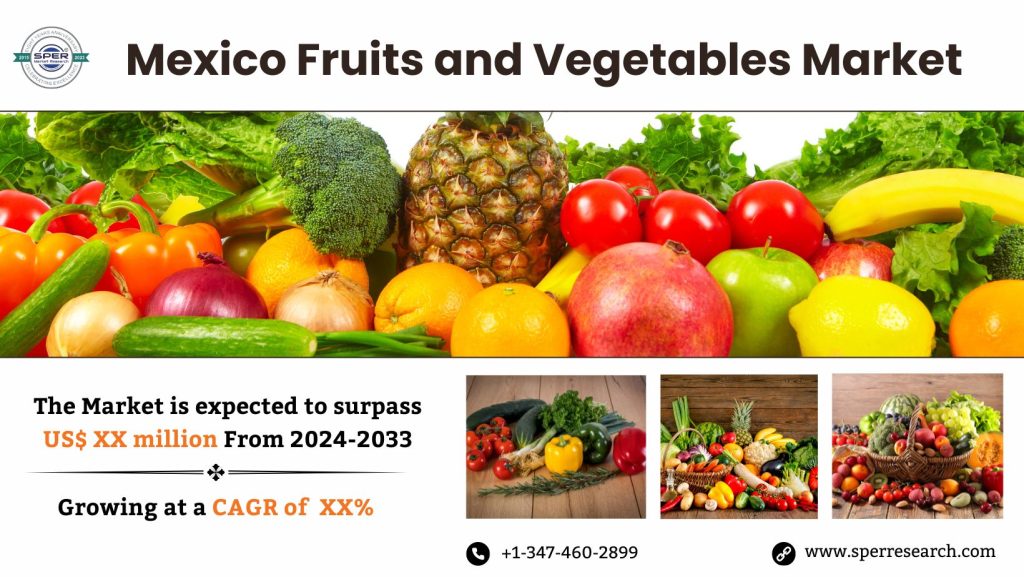Market Insights & Projections: Mexico Fruits and Vegetables Market (2024-33)
Mexico has a robust, diversified, and essential fruit and vegetable sector that supports the country’s economy. due to its favorable climate and rich soil, Mexico is a major producer and exporter of a variety of commodities, including berries, tomatoes, and avocados. The industry caters to a wide range of clients, including health-conscious individuals and major food service providers and merchants. Growing customer demand for fresh, organic, and processed veggies is promoting sustainability and innovation in the sector. With global consumption rising, Mexico’s strategic position as a key supplier makes it more significant in the global fruits and vegetable business.
According to SPER Market Research, ‘Mexico Fruits and Vegetables Market Size- By Product, By Distribution Channel – Regional Outlook, Competitive Strategies and Segment Forecast to 2033’ states that the Mexico Fruits and Vegetables Market is estimated to reach USD XX billion by 2033 with a CAGR of XX%.
Market Drivers and Challenges:
Drivers: Mexico’s fruit and vegetable sector is growing as a result of several significant causes. First and foremost, the country’s diverse climate and rich soil enable the year-round cultivation of a wide range of commodities, making it a major exporter. The benefits of fresh food and growing consumer health consciousness are driving higher demand for fresh food both locally and internationally. Growing organic farming and sustainable farming practices also attract health-conscious consumers. Since e-commerce and modern store concepts have grown, it is also simpler to get fresh food. Free trade agreements also strengthen export opportunities, highlighting Mexico’s significance in the global fruit and vegetable industry.
Download sample PDF copy of this report to understand structure of the complete report @ https://www.sperresearch.com/report-store/mexico-fruits-and-vegetables-market.aspx?sample=1
Restraints: The nation has consumed fewer fruits and vegetables over time as fast soups have become more popular and modern self-service supermarkets have replaced fruit and vegetable-based products. Therefore, in order to assist the economic success of local growers, better marketing strategies are needed to attract consumers to buy fresh items grown nearby. One of the biggest challenges to the growth of the fruits and vegetable industry in Mexico is food contamination from fruits and vegetables. Toxins can infiltrate food products through a variety of routes, rendering them unsafe for consumption. Common fruits like peach palm contain oxalates, which when consumed over time can interfere with proper growth, weaken the immune system, and possibly even cause cancer.
COVID-19 Impact on Mexico Fruits and Vegetables Market:
The COVID-19 pandemic has led to an increase in fruit and vegetable intake, which has had an impact on the agricultural industry. Every aspect of the fruits and vegetables industry has been impacted by the COVID-19 epidemic, both favorably and unfavorably. The unanticipated COVID-19 outbreak has affected the fruit and vegetable market in both positive and negative ways. This is primarily due to increased consumer awareness of the advantages of leading a healthy lifestyle, eating a plant-based diet, and exercising frequently. However, the COVID-19 pandemic’s disruption of the fruit and vegetable supply chain has hindered the market’s growth.
Market Competitive Landscape:
The Bajio region dominates the Mexico Fruits and Vegetables Market as the region has best climate and soil quality. Major players in the market are Agroindustrias de México, Apeel Sciences, Berrymex, Cermex, Dole Food Company and Others.
Key Target Audience:
- Exporters
- Food Service Providers
- Grocery Retailers
- Health-Conscious Consumers
- Hotels and Restaurants
- Importers
- Local Markets
- Processed Food Manufacturers
Mexico Fruits and Vegetables Market Segmentation:
By Crop Type:
- Fruits
- Vegetables
- Others
By Distribution Channel:
- Online
- Offline
- Others
By Region:
- Eastern Mexico
- Western Mexico
- Northern Mexico
- Southern Mexico
For More Information in Mexico Fruits and Vegetables Market, refer to below link –
Mexico Fruits and Vegetables Market Share
Others Industry Report –
- Malaysia E-Commerce Shipments Market Size- By Glass Type, By Product, By Application- Regional Outlook, Competitive Strategies and Segment Forecast to 2033
- Latin America Vegetable Oil Market Size- By Type, By Application- Regional Outlook, Competitive Strategies and Segment Forecast to 2033
- Latin America Vegetable Oil Market Size- By Type, By Application- Regional Outlook, Competitive Strategies and Segment Forecast to 2033
- Australia Last Mile Delivery Market Size- By Delivery Mode, By Application, By Destination, By Service Type, By Vehicle Type, By Mode of Operation- Regional Outlook, Competitive Strategies and Segment Forecast to 2033
- Sweden Household Electric Grills Market Size– By Product, By Type, By Application, By Distribution channel – Regional Outlook, Competitive Strategies and Segment Forecast to 2033
Follow Us –
LinkedIn | Instagram | Facebook | Twitter
Contact Us:
Sara Lopes, Business Consultant – U.S.A.
SPER Market Research
+1-347-460-2899









